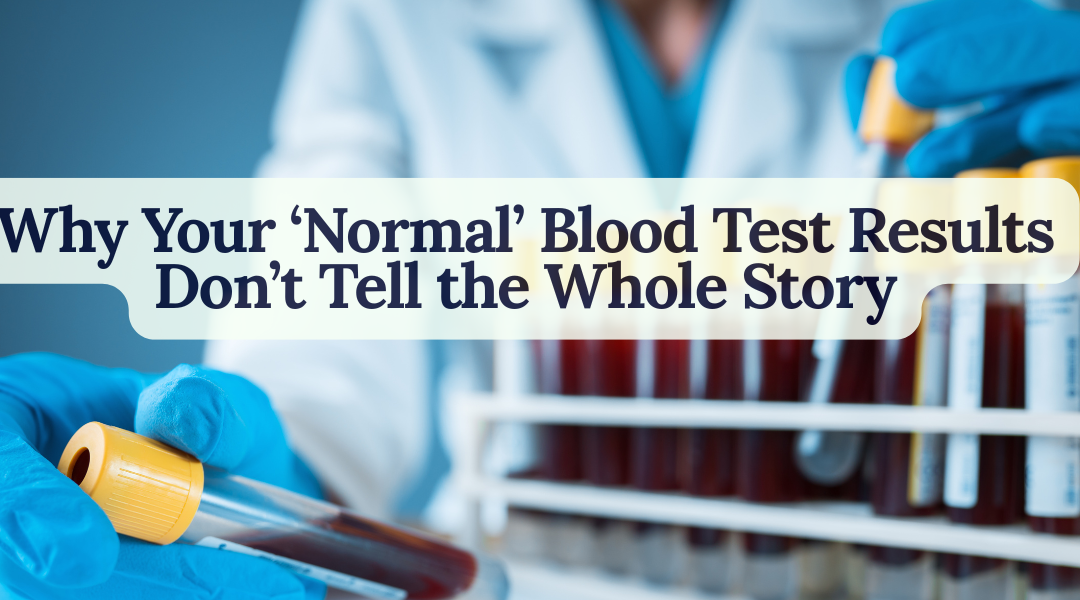“You’re Fine.” But You Don’t Feel Fine.
You wake up already tired. Midday hits and you’re dragging. Maybe your hair’s thinning or your digestion’s off. You finally go see your GP, run the usual tests, and wait for answers.
The call comes: “Everything looks fine.”
But it doesn’t feel fine.
This is one of the most common frustrations I hear from people walking into my Adelaide clinic. On paper, their health looks “normal,” but day-to-day life says otherwise.
If you’ve ever been told your labs are fine when your body says otherwise, keep reading. You’re not imagining things. You just need someone who reads blood tests differently.
Why “Normal” Isn’t Always Healthy
Let’s clear something up: conventional blood tests aren’t the problem. The way they’re interpreted often is.
Standard reference ranges used in general practice are designed to catch disease, not dysfunction. That means unless something is seriously out of whack, you’re likely to be told you’re okay—even when early warning signs are already showing up.
Here’s the catch:
- “Normal” ranges are based on population averages, not on what’s optimal for wellness
- These ranges often include people with chronic issues, skewing what’s considered “typical”.
- You could be within the “normal” range and still have clear signs of imbalance or deficiency
Functional vs. Conventional: What’s the Difference?
Functional medicine uses the same lab tests as conventional doctors, but I ask different questions.
Instead of asking:
“Does this person have a diagnosable disease yet?”
I ask:
“Is this person functioning at their best, or are there signs things are heading off track?”
Here’s how that looks in real life:
- Conventional thyroid range: If your TSH (thyroid stimulating hormone) is between 0.4 and 4.0, you’re “fine”
- Functional approach: I might flag anything above 2.0 as an early sign your thyroid is under stress, even before major symptoms appear
- Conventional B12 range: Levels above 150 pmol/L? All good
- Functional lens: Anything under 490 pmol/L could mean your nervous system isn’t getting what it needs
Real Case Study: Sarah’s “Normal” Fatigue
Patient name changed for privacy
Sarah, 37, came to me frustrated. She’d been feeling wiped out for over a year. She struggled to get through the workday and had constant brain fog. Her GP ran bloods and said everything was “within normal limits.”
Here’s what I found when I reviewed those same results:
- Iron: Technically normal, but her ferritin (iron stores) was just 18 ng/mL. I look for 70+ in women for optimal energy
- Thyroid: TSH was 3.7, inside the lab range but high enough to indicate early thyroid slowdown
- B12: Came in at 260. Again, “normal” by textbook standards, but far too low for healthy nerve and brain function
- Vitamin D: At 55 nmol/L, this was barely scraping the bottom of the reference range. I aim for 100+ for immune and mood support
With targeted support, Sarah’s energy returned. Within 3 months she reported clearer thinking, less fatigue, and a noticeable lift in her mood.
Same tests. Different story.
Why I Look Through a Different Lens
At my Adelaide-based clinic, I take time to ask deeper questions. My approach to interpreting bloodwork focuses on:
- Root-cause investigation: Not just identifying what’s off, but why
- Optimal ranges: Comparing your results to what promotes health, not just what avoids disease
- Patterns: Looking at how all your results fit together, not just one marker at a time
- Personalised context: A “normal” result might mean something different for a 25-year-old woman than for a 60-year-old man. I tailor interpretation to you
It’s not about overcomplicating things. It’s about listening to your symptoms and using lab data in a way that actually helps you feel better.
What Could Your “Normal” Bloodwork Be Hiding?
If you’re still dealing with symptoms like:
- Low energy or constant fatigue
- Brain fog or forgetfulness
- Poor sleep or mood swings
- Cold hands and feet
- Hair loss or dry skin
- Digestive issues that come and go
…it could be your bloodwork is giving clues, but those clues are being overlooked.
Many of my Adelaide patients arrive with stacks of past results, feeling dismissed. It’s not that nothing’s wrong. It’s that no one’s put the pieces together.
I Do Things Differently, And Patients Feel the Difference
One of the most powerful parts of my work is seeing people finally feel heard.
I believe that being told “you’re fine” when you feel far from it is one of the most discouraging parts of modern healthcare.
That’s why I created a space where your story matters, and your symptoms aren’t ignored just because a test result says “normal.”
Curious About What Your Results Really Say?
If you’ve been told everything looks normal but you still don’t feel well, I’d love to help you dig deeper.
Book a free 15-minute discovery call with me today.
I’ll talk about your health history, review any existing bloodwork, and see if my approach might be the missing piece.
Ready to take back control of your health?
Schedule your free call now.

